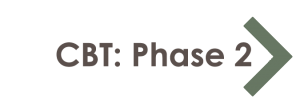
CBT: Phase 1
The initial phase is designed to provide assessment and engagement, including the development of a problem list, establishment of shared goals and the collaborative development of a maintenance formulation of a recent incident.
Ideally, a first session should include:
• Explain confidentiality, CT, trial aspects (e.g. treatment window and boosters)
• Agree short 6 session contract with expectation of renewal up to 30 hours (including boosters)
• Cognitive behavioural assessment of presenting problems and life experiences, based on cognitive model Risk assessment
• Normalising if appropriate
Ideally, by session 3, we would have:
• Agreed a shared list of problems and goals (SMART ones suitable for the agreed short-term contract; goals should ideally be related to increasing quality of life and/or reducing distress; in some instances, telling their story may be an appropriate first goal)
• Shared formulation (at least a mini-formulation of a recent specific situation, related to a problem from the list, in terms of event, thoughts, feelings and behaviour/responses with appropriate maintenance cycles):
What happened – how I made sense of it – how I feel – how I responded
Video Demonstrations:
The following resources consist of video excerpts of role plays filmed by PRU staff which aim to illustrate the relevant processes, principles and strategies within each phase. Where relevant, these videos are supplemented by descriptions and formulations that were shared with the ‘client’.
Assessment of voice hearing and developing a maintenance formulation
The therapist and client talk about a recent example of voice hearing. A formulation is developed and a discussion takes place on what may be maintaining the voice hearing. A homework task is then collaboratively set to test out what happens if the client doesn’t talk back to the voices when she hears them.
Formulation for hearing threatening voices
Assessment of thought broadcast and developing a maintenance formulation
In this video, the therapist explores a recent example of thought broadcast with the client and develops a formulation. Based on the formulation, a thought suppression task is done in session and based on the results, a homework task is set collaboratively.
Maintenance formulation for thought broadcast
Advantages and disadvantages of paranoia
The therapist formulates a recent example of paranoia with the client. They then explore the advantages and disadvantages of paranoia as a strategy to keep safe.
Formulation for paranoia
Identifying goals using a Q sort task
This role play illustrates how to use a Q sort task to help clients decide what they would like to focus on in therapy and what goals they would like to set.
Q sort card set
Normalising Voices
The therapist and client talk about what psychosis means to the client. They then explore normalising information about the prevalence of voice hearing, triggers and why people may hear voices. This offers a normalising and less stigmatising explanation for voice hearing.
Information sheet about normalising voices
Maintenance formulation of threatening voices
Developing a maintenance formulation with someone who hears voices threatening persecution from government.
Formulation of threatening, persecutory voices


